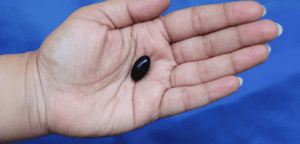R-ALA Cyclodextrin: A Therapeutic Tool for Neurodegenerative Disorders

The therapeutic potential of R-ALA Cyclodextrin in neurodegenerative disorders might be due to its ability to reduce oxidative stress and protect against mitochondrial dysfunction.
R-ALA is a natural nootropic that has been found to have increased levels of acetylcholine, serotonin, dopamine, GABA, and norepinephrine.
It also possesses antioxidant properties that might be related to its protective action on the mitochondria.
In this article, we'll review the neuroprotective effects of R-ALA on mitochondrial function and also discuss its therapeutic potential as a Nootropic.
What is R-ALA Cyclodextrin?
ALA is a fatty acid that may be obtained from greener sources. It promotes good oxidation in our mitochondria, which is beneficial to health.
Alpha Lipoic Acid is found in certain fruits and vegetables, but it has poor bioavailability and stability.
Another approach to enhance this is to choose the most active enantiomer, R Alpha Lipoic Acid (R ALA), and then stabilize it.
In the past, this was accomplished by adding Sodium to make Sodium R Alpha Lipoic Acid (Na-R-ALA).
R Alpha Lipoic Acid (R ALA) was stabilized within a cyclodextrin complex to create R ALA Cyclodextrin, which improved bioavailability and stability significantly more than did sodium stabilization.
R ALA Cyclodextrin is a typical and popular antioxidant that helps your body remove harmful free radicals.
This makes R ALA Cyclodextrin, without a doubt one of the greatest supplements for improving oxidation levels in general, especially in the Mitochondria.
What is the R in R alpha-lipoic acid?
The two forms (isomers) of alpha-lipoic acid have significantly varied characteristics.
The "R" form is the biologically active component (natural to the body) that gives lipoic acid its outstanding antioxidant effect.
The "R" form is made via chemical synthesis and is not very biologically active.
A 50/50 ratio of the "R" and "S" forms make up alpha-lipoic acid supplements. That means a 100 mg alpha-lipoic acid pill contains 50 mg of the bioactive "R" form.
R-lipoic acid, the active form, is naturally synthesized and utilized by the human body.
R-lipoic acid is more effective than the combined "R" and "S" forms that make up alpha-lipoic acid in reducing inflammatory responses.
What is the difference between ALA and R Ala?
Alpha-lipoic acid (ALA) is a vitamin-like antioxidant, whereas R-lipoic acid is the cis form of alpha-lipoic acid.
ALA is made in animals normally and is essential for aerobic metabolism.
R-lipoic acid acts as a cofactor in the mitochondrial enzymatic production of energy.
In other words, R lipoic acid is an essential nutrient to mitochondria and it must be present for them to function normally.
R-lipoic acid has been found to support healthy insulin function and glucose metabolism in the mitochondria of diabetic patients.
It may also protect against fatty liver disease by preventing fat accumulation within cells (hepatocytes).
On top of all this, it may help to reduce oxidative stress and blood pressure.
What are the benefits of R-ALA Cyclodextrin?
When it comes to antioxidant activity, R-lipoic acid is a powerful biomolecule.
It can prevent oxidative damage to proteins by reacting with lipid peroxides and preventing the formation of malondialdehyde (MDA), which is a highly toxic metabolite from oxidized lipids in cell membranes.
In addition, it blocks nitrosative stress by preventing nitric oxide from binding to superoxide, thus reducing the formation of peroxynitrite (ONOO-).
On a similar note, R ALA Cyclodextrin may help protect mitochondria against oxidative damage.
It also appears to be neuroprotective and promotes synaptic plasticity in neurons. It's even been shown to be effective in crossing the blood-brain barrier.
This makes it a great Nootropic for anyone who wants to improve brain health and function.
What about the side effects?
R-ALA Cyclodextrin is very safe.
It's even been shown to be helpful in cases of diabetic neuropathy, hepatitis C, alcohol liver disease, and poisoning with heavy metals like mercury or lead.
Due to its low toxicity profile, R-ALA Cyclodextrin can be taken in large doses.
This is especially true in cases of mitochondrial dysfunction, which increases the need for antioxidants like R-ALA Cyclodextrin to protect mitochondria from oxidative damage.
That being said, some side effects may include diarrhea, nausea, and vomiting.
Mostly digestive issues in sensitive individuals who take too much at once.
It may lower blood sugar as well so it's recommended that diabetics monitor their glucose levels carefully while taking this supplement.
What is the recommended dosage of R-ALA Cyclodextrin?
The typical dose for a therapeutic effect is 250 to 500 mg, two times per day.
In some cases, doses as high as 1500mg have been used without suffering any adverse effects.
I recommend taking it on an empty stomach to improve bioavailability, especially if you are using high doses.
You can also take it with a choline source to increase the effects. Alpha-GPC or Citicoline are great choices for this.
You may also stack it with Acetyl L-Carnitine to gain the benefits of their combined compounds.
Mitochondrial density and function may be enhanced by the use of Alpha Lipoic Acid and Acetyl L-Carnitine, in particular.
In Summary
R-ALA is a powerful antioxidant that protects mitochondria against oxidative damage, in addition to providing neuroprotective effects.
It's been shown to be helpful for those with diabetic neuropathy, hepatitis C, alcohol liver disease, and poisoning from heavy metals like mercury or lead.
This nootropic can also cross the blood-brain barrier which makes it great for improving brain health and function as well as promoting synaptic plasticity among neurons.
Side effects may include diarrhea, nausea, and vomiting but are mostly digestive issues experienced by sensitive individuals who take too much at once.
The typical dose of R-ALA Cyclodextrin is 250mg two times per day while doses up to 1500 mg have been used without suffering any adverse side effects.
I recommend taking this Nootropic on an empty stomach to improve bioavailability, especially if you are using high doses.
You can also take it with a choline source like Alpha-GPC or Citicoline to increase the benefits.
Additionally, stacking R ALA Cyclodextrin together with Acetyl L-Carnitine may further improve mitochondrial function.
